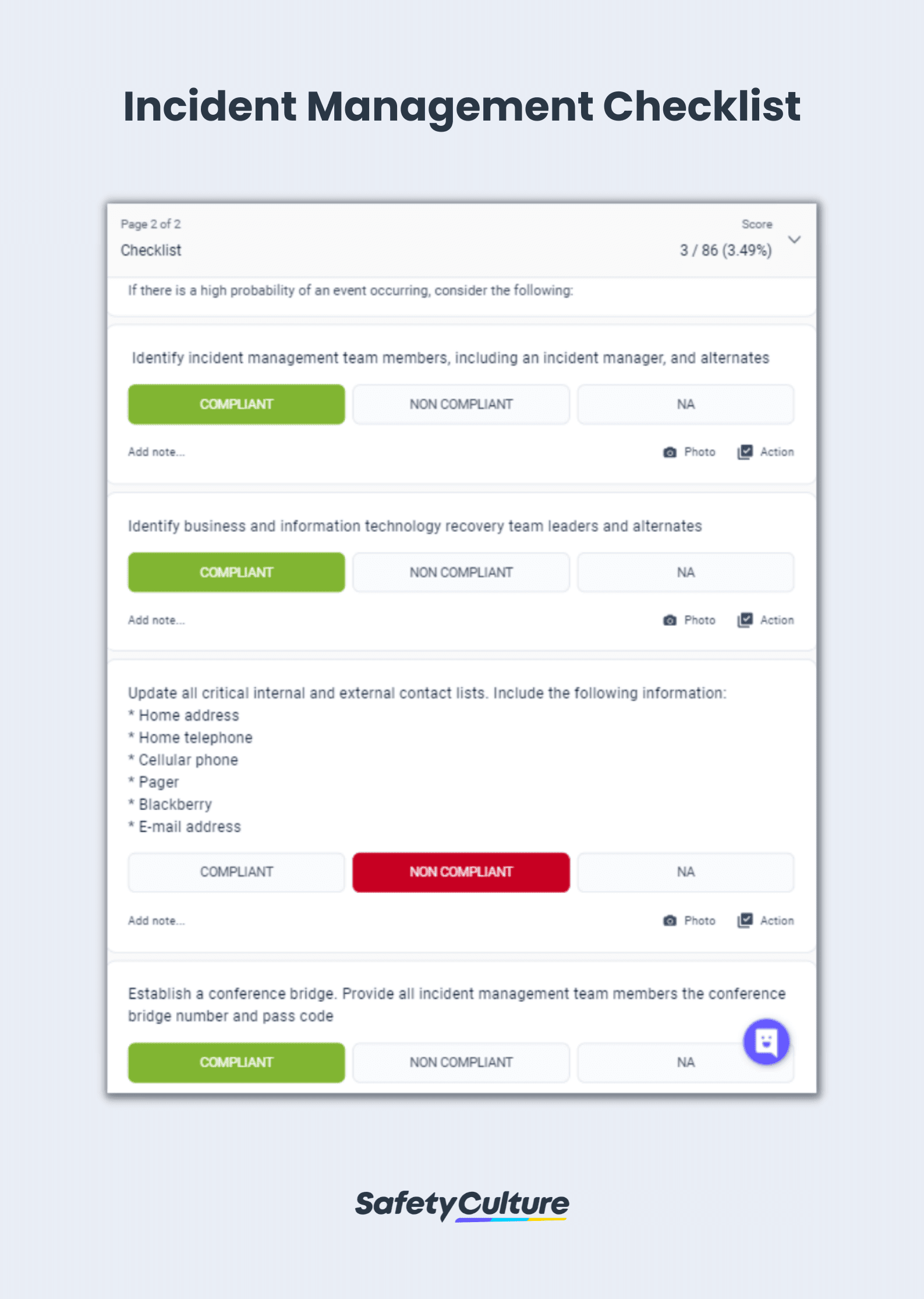What is an Incident Management System?
An incident management system is set up to help an organization and its workers react to, understand, and respond to an emergency. It combines the four factors—personnel, equipment, procedures, and communications—to help provide a better understanding of an incident and its potential causes. Data about the incident is vital in making an incident management system effective, and the persons responsible should have access to as much of this data as possible at the soonest possible time.
An incident management checklist is a useful tool because it presents the detailed steps that should be taken during the management of a crisis or incident in the workplace. Even businesses that don’t deal with dangerous situations or hazardous materials are advised to have an incident management system in place because it provides a plan of action for the organization in the event of an emergency. Incident management checklists should ideally contain all as much relevant information regarding an incident as possible, including how to respond to a specific incident and how to detail the events that transpired into a cohesive report.
How to Create the Checklist
Creating an incident management checklist will depend on a variety of factors, not least of which, is the organization’s nature of business. Regardless of the type of work done, however, there are common steps that will help ensure an effective checklist and incident management process.
- Researching and reviewing past incidents and how the business responded to them.
- Brainstorm potential incidents and near-misses that could occur unexpectedly at your worksite or place of business.
- Decide on what series of corrective actions to take depending on the incident and list down the steps in a simple, easy-to-understand manner.
- Once the incident management system checklist is created, conduct a training seminar on its purpose and usage so the necessary personnel can use the checklist.
- Share the incident management system checklist with employees and management teams.
Be proactive and when creating the checklist, it’s important to note that it’s next to impossible to create one that will cover every situation. This is why reviewing past incidents is vital because it can provide insight into what to look out for and what other incidents can occur in the workplace. There will always be unforeseen incidents and unavoidable accidents; what’s important is that the organization creates an incident management system checklist that’s flexible enough to be useful in such circumstances and can easily be revised or modified to address unexpected incidents.
5 Tips for Creating an Effective System
The creation of an effective incident management system often involves a long list of detailed steps, especially for businesses that are involved in the handling of hazardous substances. However, the 5 simple steps below can help any organization get started on protecting their employees from workplace incidents.
- Identify and log all incidents to help determine and address their root causes. This also creates a log that employees can check in case more serious incidents emerge that are related to this event and helps educate them about past incidents so they know how to manage these in case of recurrence.
- Categorize and prioritize incidents to determine which ones to address first. Understanding the incident and the events that led to it will help employees determine the proper plan of action.
- Report the incident to the proper authorities. An incident management system checklist or an incident response plan often contains a list of people who are capable and authorized to handle the report and deal with the situation. Sometimes, the involvement of higher-authority individuals may be required; such conditions are listed in the checklist.
- Create an incident management team and discuss the details regarding the management of incidents. This is done after the initial incident has been addressed to help avoid recurrence and formulate solutions to help avoid similar incidents in the future.
- Create an on-call emergency incident response team comprised of individuals that can escalate and address severe incidents as they occur. This team of responders is also responsible for walking employees through the steps of the incident management system.
Incident Management Checklist Examples
Here are incident-related templates that businesses can use in their daily operations:
Incident Investigation Templates
Incident investigation templates can help guide those who report incidents on what information to provide to help better understand the cause of an incident. Use this incident investigation template to provide information on contributing factors that may have led to the incident so that safety officers can determine preventive measures.
Accident Investigation Report Templates
Considering that accidents are always harmful, destructive, and negatively impact operations, actions should be taken to avoid the recurrence of accidents. Use this accident investigation report template to provide all pertinent information surrounding an accident and be able to include photos for better context. Instantly submit the result of the accident investigation and assign corrective actions that can be tracked until completion. Determine the root cause of an accident using the collected information and devise measures to prevent it from happening again.
Near-miss Report Forms
Report instances of near-miss using near-miss report forms like this template that can be downloaded for free on mobile or used as a PDF. Indicate if a near-miss requires a pause in operations or if a business should continue as usual. The information on near-miss reports should clarify the event and help prevent its recurrence.
COVID-19 Incident Management
As the COVID-19 global pandemic continues to affect businesses in all industries the world over, it’s important that organizations have an action plan in place to address incidents and other concerns related to the virus. COVID-19 has affected different economies in unprecedented ways, and its effects have been felt—and will continue to be felt for the foreseeable future—by both businesses and consumers.
Because COVID-19 is a different kind of monster, and one that hasn’t been tamed by time and experience, organizations should have a means to address and mitigate issues or concerns resulting from it. Proper communication and information dissemination is important, in light of the misinformation caused by inaccurate data and baseless information presented as facts on social media and other online channels. To help curb the spread of the virus and manage related incidents, the COVID-19 checklists below can be used to check for symptoms, monitor regular sanitation procedures, and help employees conduct self-assessments.



